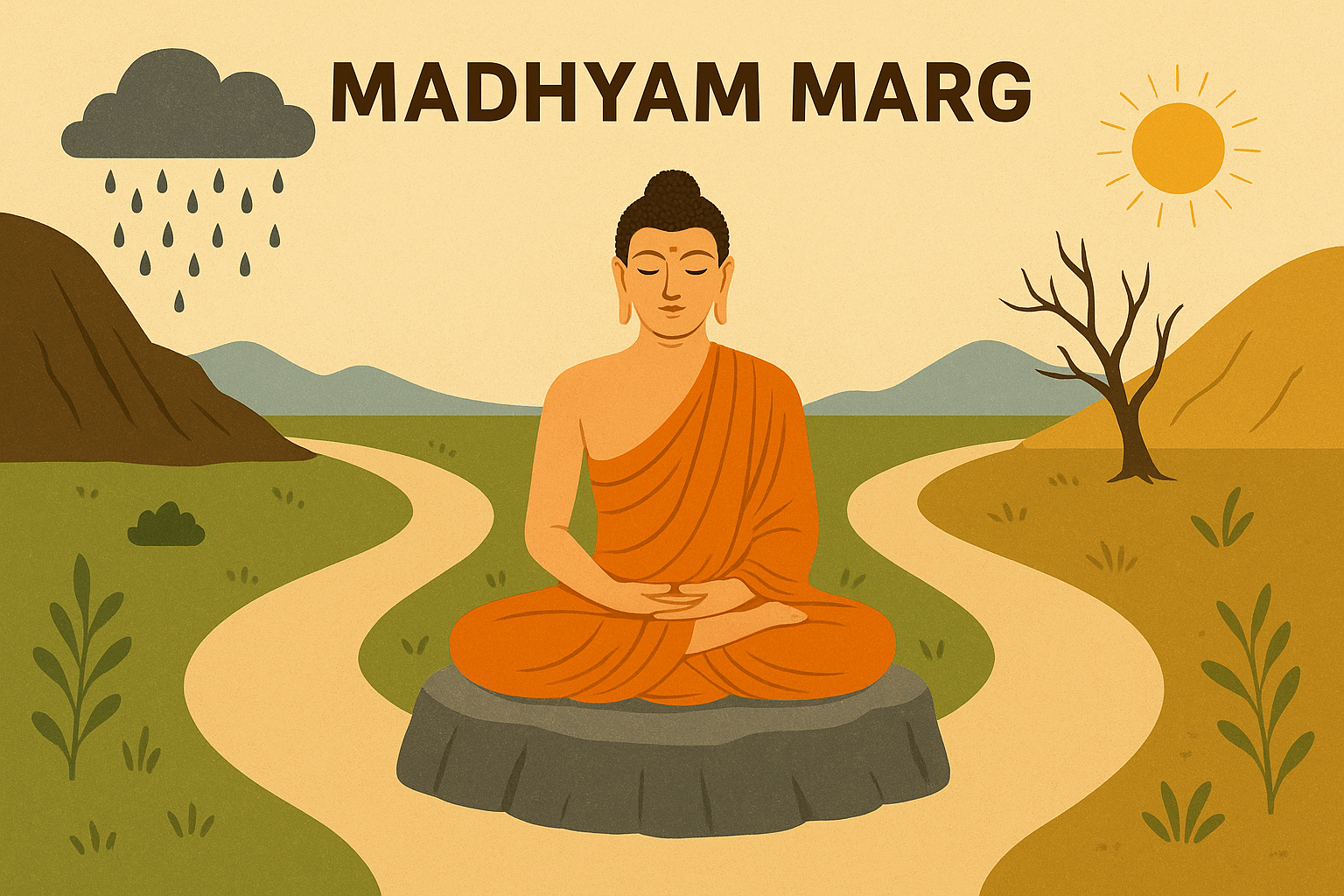Introduction
Among the many teachings of Lord Buddha, the Madhyam Marg — or the Middle Path — is one of the most profound and practical. It is not a philosophy for monks alone, but a way of living that can guide everyone in daily life. At its heart, the Middle Path teaches us to avoid extremes and find balance — in our thoughts, actions, and lifestyle.
Background: Why the Middle Path?
Lord Buddha, born as Prince Siddhartha, lived two opposite extremes in his early life:
- Extreme Luxury – As a prince, he had every comfort, wealth, and pleasure. But this did not bring lasting peace or happiness.
- Extreme Austerity – After leaving the palace, he practiced severe penances and self-denial, almost starving himself. Yet he realized that harming the body and mind does not lead to wisdom either.
From this experience, he discovered that true peace lies not in indulgence nor in severe self-denial, but in a balanced way of living — the Madhyam Marg.
The Philosophy of Madhyam Marg
The Middle Path is at the very foundation of Buddhism. It is the guiding principle that led to the Buddha’s first sermon at Sarnath, where he explained it as the way to avoid extremes and move towards liberation (Nirvana).
It can be understood through two main aspects:
1. Avoiding Extremes
- Not drowning in pleasures and desires.
- Not torturing or punishing yourself unnecessarily.
2. Following the Noble Eightfold Path
Buddha explained that the Middle Path is lived practically through the Eightfold Path, which includes:
- Right View (understanding reality and truth)
- Right Intention (goodwill, non-violence)
- Right Speech (kind and truthful words)
- Right Action (ethical conduct)
- Right Livelihood (earning without harm to others)
- Right Effort (avoiding negativity, cultivating goodness)
- Right Mindfulness (awareness of thoughts and actions)
- Right Concentration (deep meditation and focus)
This path creates harmony between our body, mind, and spirit.
Why is Madhyam Marg Unique?
- Practical for All: It doesn’t demand extreme sacrifices, nor does it encourage careless enjoyment. Anyone — rich or poor, young or old — can follow it.
- Universal Relevance: It is not limited to religion. It is a universal principle of balance, much like walking a straight road instead of swaying from side to side.
- Balance for Inner Peace: It teaches moderation, balance, and wisdom — qualities often missing in today’s stressful world.
How Can We Learn from Madhyam Marg Today?
In modern life, extremes still exist:
- Chasing endless money and pleasures, leading to stress.
- Or withdrawing completely from life’s responsibilities.
Buddha’s Middle Path suggests:
- Work hard, but don’t become a slave to work.
- Enjoy pleasures, but don’t let them control you.
- Take care of your body, but don’t over-indulge or neglect it.
- Stay aware and mindful, without being overly anxious.
This balance helps us live with calmness, clarity, and compassion.
Inspiration for Daily Life
- In family life: Balance between love and discipline, between self-care and caring for others.
- In work life: Balance between ambition and contentment.
- In personal growth: Balance between discipline (effort) and relaxation (rest).
- In spirituality: Balance between faith and reason, between meditation and daily duties.
Conclusion
The Madhyam Marg is not just a spiritual teaching; it is a life philosophy that guides us to live wisely and peacefully. Lord Buddha showed that true happiness does not lie at the extremes, but in the middle — in balance, awareness, and compassion.
For the common man, it is a reminder: Don’t run to either extreme. Walk steadily in the middle, and life becomes more peaceful, meaningful, and fulfilling.

Leave a Reply